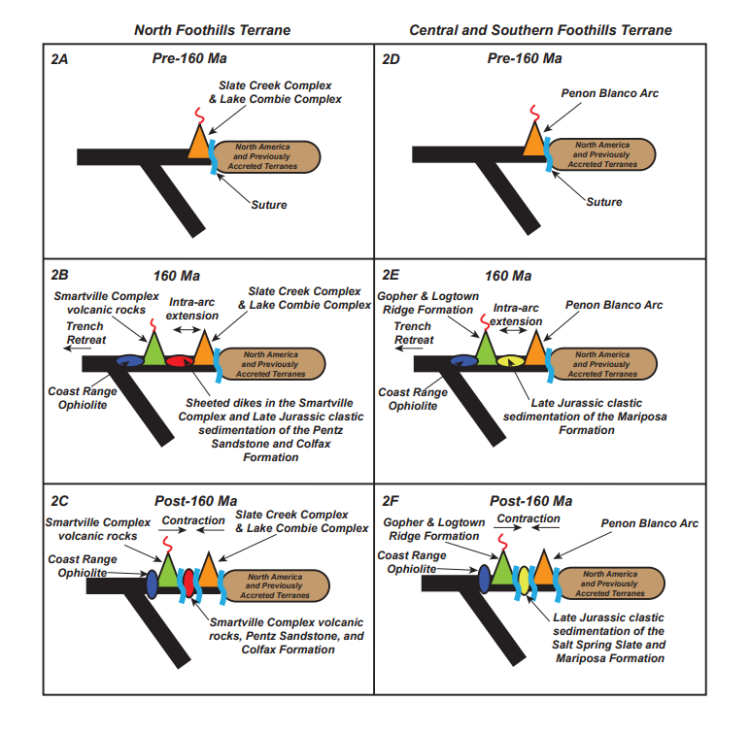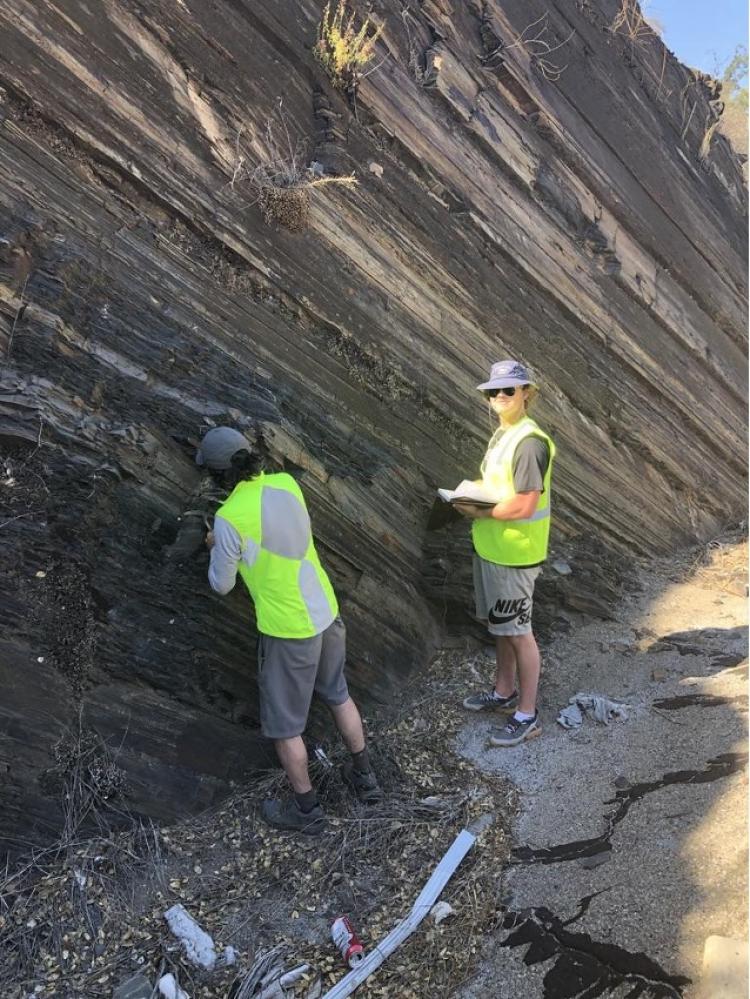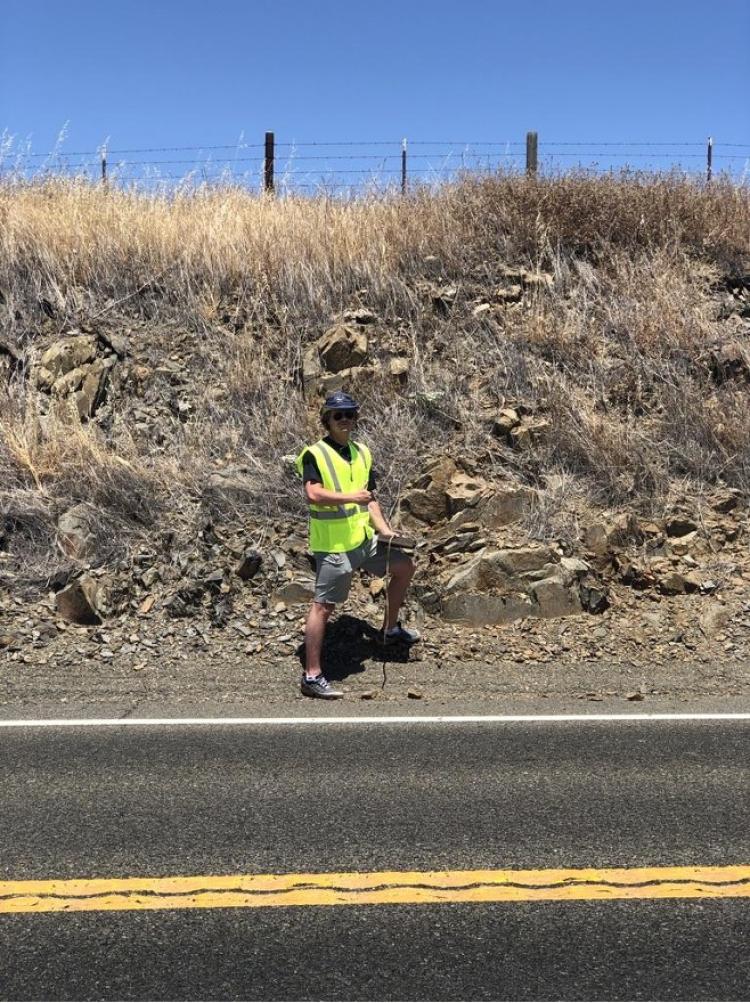Jack Simmons - Project Profile
2021 AGeS awardee
Lab: USGS LA-ICP-MS Isotope Research Lab, Denver, CO
What scientific question(s) does your research address and what motivates this work?
My research project addressed the controversy regarding the plate tectonic reconstruction of the western North American Jurassic plate margin in the Sierra Nevada foothills metamorphic belt of California. Despite decades of research, questions remained regarding the tectonic configuration of the Jurassic plate margin recorded in the Foothills terrane of the Sierra Nevada foothills metamorphic belt of California, which motivated this work. Historically, workers supported a west-dipping subduction model (Fig. 1) where all rocks of the Foothills terrane are exotic and developed in an intra-oceanic setting. This reconstruction is used in recent models (2020) based on tomographic images of near-vertical slabs in the mantle. In contrast, other workers have presented data supporting a long-lived east-dipping subduction model (Fig. 2) where rocks of the Foothills terrane are endemic to the continental margin of western North America. I performed a sedimentary provenance study by utilizing U-Pb detrital zircon geochronology and sandstone petrofacies analysis to test these two conflicting models. Exotic models required that Middle–Late Jurassic clastic units either lack pre-Mesozoic zircon, or contain pre-Mesozoic zircon derived from non-North American sources. Endemic models required that pre-Mesozoic detrital zircon in Middle–Late Jurassic clastic units can be matched to well-characterized North American sources.
What chronometric tool did you employ and why?
The chronometric tool of choice for this research project was the laser ablation–inductively coupled plasma–mass spectrometry (LA–ICP–MS) method. I employed the LA–ICP–MS method for U-Pb ion counts and ratios on detrital zircons because it allowed for rapid and accurate data acquisition, in a short period of time, at a moderate to low cost. The LA–ICP–MS method has been shown by a number of laboratories to calculate U-Pb detrital zircon ages with great accuracy and precision, as compared to other geochronologic methods. The LA–ICP–MS method is also commonly used in sedimentary provenance work and maximum depositional age assessments because of the many advantages described above.
What were some of the key takeaways of your research?
- Sandstone petrofacies results showed the Middle–Late Jurassic clastic rock of the Foothills terrane are sourced from volcanic and orogenic highlands.
- U-Pb detrital zircon geochronology results showed that the Middle–Late Jurassic clastic rock of the Foothills terrane contain up to 89% Precambrian grains that are compatible with sediment source contributions from the continental interior of North America.
- These results are in support of the long-lived east-dipping subduction model where rocks of the Foothills terrane are endemic and formed in proximity to the western North America.
- Maximum depositional ages younger than ca. 150 Ma in Middle–Late Jurassic clastic rocks are compatible with models for Late Jurassic–Early Cretaceous deformation and regional cleavage development in rocks of the Foothills terrane during re-accretion of the endemic volcanic arc-basin rocks and subsequent evolution of the stress regime in the fore-arc setting.

Figure 1: Simplified schematic diagram illustrating exotic arcs (i.e., Foothills terrane) that developed above a west-dipping subduction zone. Mezcalara oceanic lithosphere is attached to North America and subducting westward beneath the exotic arcs. Adapted from Sigloch and Mihalynuk (2015).

Figure 2: Simplified schematic diagrams illustrating the endemic model for the Foothills terrane in Jurassic time. Rocks of the Foothills terrane are located west of previously accreted terranes. In the northern portion of the Foothills terrane: (5A) Formation of the Slate Creek and Lake Combie complexes occurred on the continental margin of North America. (5B) Fore-arc rifting forms the Coast Range ophiolite and intra-arc rifting forms the Smartville Complex volcanic rocks and associated sheeted dikes. Late Jurassic clastic sedimentation of the Pentz Sandstone and Colfax Formation initiates. (5C) Subsequent contraction occurred from ca. 160(?)-145 Ma and led to the accretion of the Coast Range ophiolite, Smartville Complex, Pentz Sandstone, and Colfax Formation to the North American continental margin. In the central and souther portions of the Foothills terrane: (5D) Formation of the Penon Blanco Arc occurred on the North American continental margin. (5E) Fore-arc rifting forms the Coast Range ophiolite and Intra-arc rifting forms the Gopher Ridge and Logtown Ridge for mations. Late Jurassic clastic sedimentation of the Mariposa Formation initiates. (5F) Subsequent contraction occurred from ca.160(?)-145 Ma and led to the accretion of the Coast Range ophiolity. Gopher Ridge, Logtown Ridge, Mariposa formations, and Salt Spring Slate to the North American continental margin Late Jurassic clastic sedimentation of the Mariposa For mation and Salt Spring Slate persisted through Late Jurassic time.
What new experiences, opportunities, and collaborations did you gain as an AGeS-Grad awardee?
Being an AGeS-Grad awardee was absolutely critical in the development of my research project as a whole. The award funded my analytical work and allowed me to collaborate with the USGS radiometric isotope lab located in Denver, Colorado. Although I couldn’t be physically present at the laboratory because of the COVID-19 pandemic, I still gained valuable experience virtually on how the analytical methods were performed on the detrital zircon grains. This funding also allowed me to analyze more samples and supplemented my results that all support the long-lived east-dipping subduction model.
What is one piece of advice you have for future AGeS-Grad award applicants or awardees?
The biggest piece of advice I have for future AGeS-Grad awardees is to fall in love with the research project and give it your all. Passion and hard work leads to uncovering new ideas about your project area that you may not have even been anticipating (Which is why we all fell in love with geology in the first place, right?).

Figure 3: University of North Carolina at Wilmington M.S. Geology student Jack Simmons (pictured right) and advisor Dr. Todd LaMaskin (pictured left) analyzing an exposed Mariposa Formation outcrop for detrital zircon whole rock sampling.

Figure 4: University of North Carolina at Wilmington M.S. Geology student Jack Simmons at a targeted exposed Mariposa Formation outcrop.

